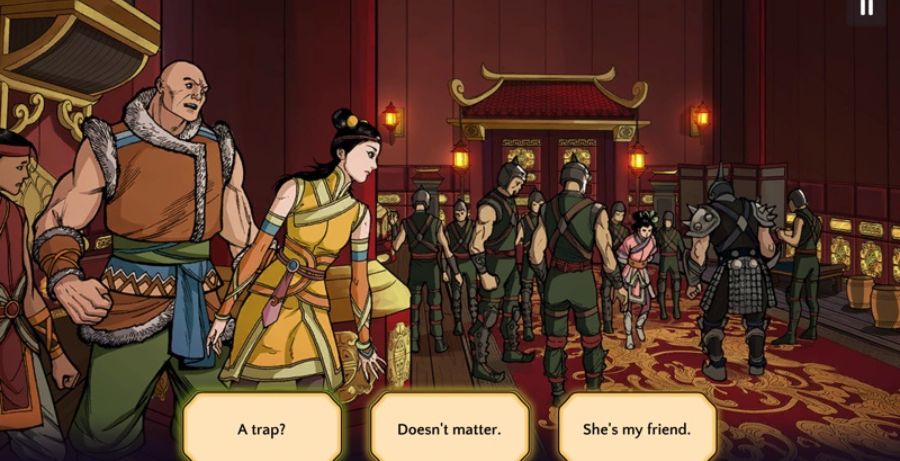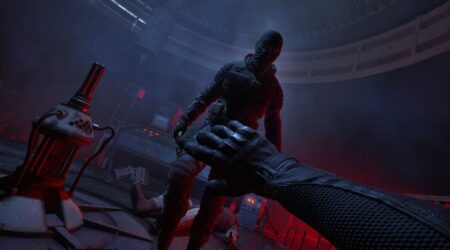Princess Shuyan lived a peaceful life practicing kung fu and learning the ways of the court in her father’s quiet kingdom. Until the invading armies of the Guer came and upended that life, now in exile, she must find the inner strength to free her people and overthrow the Guer’s brutal leader in the visual novel Shuyan Saga developed by Lofty Sky Entertainment and published by ESDigital Games.
There are two distinct sides to Shuyan Saga‘s play experience. There is the story and the combat. Let’s focus on the game’s stronger element first, the story. The journey this game leads players on is split into three distinct acts, each forming a leg of Shuyan’s journey. This structure works nicely at a narrative level and provides players with convenient stopping points where they can step away if they need to.
The narrative within these acts brings a solid tale of personal growth for its protagonist. While the narrative gives the player numerous opportunities to direct Shuyan’s interactions with the characters she encounters, it never treats the young princess as a blank canvas for the player to fill in as they wish. Shuyan has core ingredients to her personality that are immutable. The player simply gets to provide a bit of extra seasoning to make their version of the character a bit more their own. While this may be a disappointment to some, I liked that Shuyan was allowed to have a more stable personality rather than shifting and changing with my every whim.
While I appreciated how solidly Shuyan Saga handled its protagonist, I found the impact of your choices to be fairly uninspired. There are only a handful of times I felt like the story would change depending on my choices, and most of those seemed purely cosmetic with little to no actual narrative impact. It would’ve been nice if a few choices could’ve brought more impact to the story.

Beyond its treatment of its main protagonist, Shuyan Saga delivers a solid tale of struggle, redemption, martial arts, and Eastern myth. As Shuyan finds herself thrust into a larger world than she previously knew, the story guides her and the player through the narrative beats that see her grow at the hands of a wise master, struggle with the judgments of others, and eventually return to her home as a powerful liberator. It is a rewarding tale to experience, particularly given its short runtime.
The visuals during the game’s narrative elements are presented through still images. While not overly detailed for the most part, these screens do a good job of conveying the emotions in the tale’s various moments. When the story reaches its epic conclusion, Lofty Sky Entertainment pulls out all the stops to deliver a monumental canvas that feels worthy of the powerful moment it represents.
While the narrative side of Shuyan Saga mostly delivers on its goals, the actual gameplay is far more of a mixed bag. Split into two parts, one for single combat and one for taking on crowds of enemies, both sides of the experience come hampered by janky controls and frustrating moments.
When facing off against multiple enemies, the game delivers a top-down view of the field as Shuyan confronts her opponents. Combat in this form is more simplified than in single combat, with Shuyan having only a single attack button, a dodge roll, and a judo-style throw in her arsenal, plus a couple of special moves she unlocks later in the game. When everything is functioning properly, this system provides a paced experience that rewards the player when they properly manage the incoming threats, as well as time strikes and defensive maneuvers.

Unfortunately, there are frequent moments when everything does not work properly. When a strike lands or doesn’t, it can be finicky, often leaving the player open to opponents’ attacks. Perhaps the biggest frustration for me came with Shuyan’s throw maneuver. If I mistimed a throw so it didn’t connect, I would find my character completely immobile for a couple of seconds, unresponsive to any input I gave. This often left me catching punches from opponents that felt like cheap shots. While the damage dealt by individual attacks is small enough that I managed to progress steadily through the game despite these annoyances, they still brought my overall enjoyment of these sequences down noticeably.
Single combat is a more complicated affair with high and low strikes, dodges, counterattacks, blocking, combos to manage, and special maneuvers that can be triggered when special gauges fill. A number of frustrating design choices hamper this complex system of actions. The biggest of these is how it lays out the commands on the controller. From counterintuitive decisions like having the Y button be for low attacks while X is for high attacks, despite the opposite feeling natural given their relative placement to each other, to awkward placements like forcing the player to use the d-pad for the dodge and counter commands instead of the much more accessible thumbstick, the gameplay struggles to come together smoothly. The way the enemy interacts with you also brings frustrating elements to these combat moments due to what feels like an imbalance between how they act and how the player gets to during a fight.
While the AI seemed capable of breaking my attacks up with a block, even if I landed my first strike, I never seemed capable of getting out of a punching spree my opponent unleashed on me until it was over. While this disparity never hurt the combat’s balance, as I overcame most enemies on my first try, it nevertheless added a frustrating element to the battles. It felt counter to the narrative tale that was taking place. Shuyan is supposed to be growing in skill, yet she seems incapable of doing things enemy grunts succeed at all the time.
The AI’s commitment to a block is another element of single combat that holds it back. Frequently, the enemy would assume a preemptive block and be willing to hold it for several seconds. waiting for me to strike. This early commitment to blocks would’ve led to quick deaths for many of my adversaries if not for my brain’s insistence that Y should be high attack, causing me to mispress and punch straight into my opponent’s poorly executed defense.

The visuals during both sides of combat are simple but effective. Attacks are shown clearly, and visual cues warning the player of what’s about to be unleashed are well implemented. The animations overall feel a bit stiff, especially given how the narrative still art presents the elegance of the characters.
Once the campaign is done, Shuyan Saga also offers players a couple of side modes to explore. A side story following another character is unlocked upon completion of the main story. Along with plenty of combat moments that play on par with the main story’s, some light adventure elements are also worked into this mode. Dodging traps are worked into the adventure here, but they mostly only hamper the journey. Getting around spike traps is frustrating, and wall dart traps only serve to highlight the clunkiness of controls.
There is also a tournament mode where players can take Shuyan through a rigorous series of one-on-one fights of ever-increasing difficulty. The scaling difficulty of the fights quickly shines a greater light on the shortcomings of the combat. Frustrating choices that were merely annoyances during the story come fully to light in the harder battles the tournament mode throws at you.
So, while Shuyan Saga delivers a fairly fulfilling narrative that allows the player a reasonable amount of control in crafting their version of Shuyan, the active elements of the game hold it back from being a truly enjoyable experience. Hampered as it is, Shuyan Saga feels bereft of the balance its titular character seeks to achieve.
Shuyan Saga is available now on PC and will be available on Xbox Series S/X, PlayStation 5, and Nintendo Switch on September 22nd.
Shuyan Saga
-
Rating - 5/105/10
TL;DR
So, while Shuyan Saga delivers a fairly fulfilling narrative that allows the player a reasonable amount of control in crafting their version of Shuyan, the active elements of the game hold it back from being a truly enjoyable experience.





